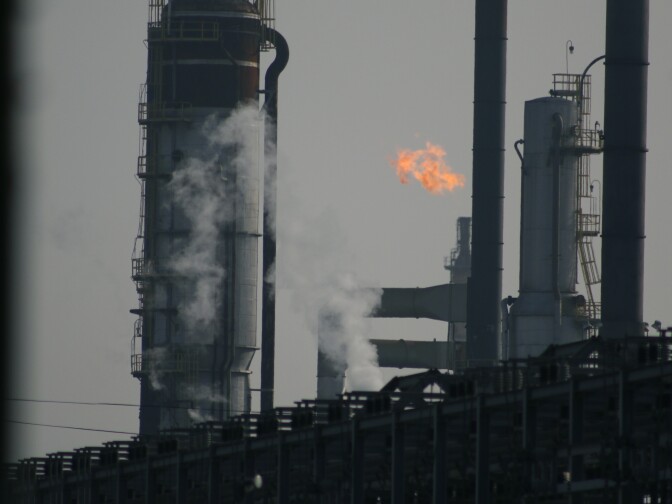Truth matters. Community matters. Your support makes both possible. LAist is one of the few places where news remains independent and free from political and corporate influence. Stand up for truth and for LAist. Make your tax-deductible donation now.
This archival content was originally written for and published on KPCC.org. Keep in mind that links and images may no longer work — and references may be outdated.
LA-area refineries emit up to 12 times more toxic chemicals than reported
Refineries in greater Los Angeles are emitting up to 12 times more toxic chemicals than previously reported, according to a new study by Swedish researchers and the South Coast Air Quality Management District.
The results, which were unveiled at the American Geophysical Union conference in San Francisco earlier this month, have substantiated the concerns environmental justice advocates and residents of industrial cities like Torrance, Carson and Wilmington.
Those advocates have complained of headaches, cancer and other health problems that they attribute, in part, to the area’s numerous refineries.
“Now we are validated for what we’ve been experiencing and saying to AQMD all along, that we were not satisfied about the type of analysis they were doing,” said Alicia Rivera, a community organizer in Wilmington for Communities for a Better Environment. “Finally, AQMD did the proper study that the community deserves.”
There is a growing body of evidence that refineries are underestimating emissions of volatile organic chemicals (or VOCs), things like benzene, xylene and toluene. Indeed, the Environmental Protection Agency wrote a memo to staff about this topic back in 2007. Exposure to these chemicals can cause headaches, fatigue, dizziness and cancer.
Since then, real-time monitoring technology has come a long way, allowing researchers to quantify just how much emissions may be underestimated, and what chemicals, exactly, are being emitted.
Last fall, AQMD partnered with researchers from Sweden to put mobile monitors on vans and drive around the fence line of six refineries in the South Coast (the agency won’t release the names of the refineries until January, when it makes the results public).
They found that VOC emissions were three to 12 times greater than what refineries were officially reporting.

“That’s very typical. People have done the same sort of [study] in other areas and invariably, it’s a similar result,” said Jay Olaguer, the director of air quality science at the Houston Advanced Research Center, who was familiar with the AQMD study but not involved with it.
That’s because currently, most refineries do not measure their emissions. Instead, they use an engineering handbook to calculate what emissions from flares, tanks, pipelines, smokestacks and valves might be, and then report their best estimate to state and federal regulators.
“It’s only somewhat better than a wild-ass guess, but it’s basically a wild-ass guess,” said Olaguer, who has authored a book on air emissions from the oil and gas industry. The calculations do not capture things like unexpected days of flaring, releases of hydrocarbons or leaks, he said.
Matt Miyasato, the deputy executive officer for science and technology advancement at AQMD, whose team undertook the study, said his agency’s findings made him skeptical of the emission calculation method, which is used by both the Environmental Protection Agency and AQMD to figure out how much progress is being made towards meeting Clean Air Act standards for pollutants like ozone.
“It makes us want to investigate these calculations better,” he said. “How were these calculations developed? Can we inform the EPA on what would be a more accurate way to resolve those?”
The reason why the calculation method is used at all at refineries is because until recently, real-time monitoring technology didn’t exist.
“This is an area which is undergoing rapid development,” Olaguer said. “There’s a whole new generation of analytical techniques that allow us to do much more than what we were able to do some time ago.”
Indeed, in November the AQMD board set aside over $720,000 to continue real-time air monitoring around refineries in Carson and Wilmington next year.
“We’re concerned about it. That’s why we’re continuing the investigation,” said Miyasato.
He said the next step is to figure out when to use which type of remote monitoring, and how accurate each technology is. For example, should the new remote sensors be used to help refineries detect leaks? To give real-time emissions data to community members? To monitor emissions for official reporting purposes?
Whatever AQMD decides, it will likely take a long time to change how refineries are required to report their emissions.
"EPA is heavily invested in the conventional technology," said Olaguer. "Like an elephant, you can't just turn it around on a dime."
But Alicia Rivera, the community organizer, wants the AQMD to crack down now.
“How can you allow polluters to say how much pollution they are emitting? That’s a joke,” she said. “I would hope (AQMD) would take the necessary steps to regulate what has been underreported and penalize the refineries for underreporting. And put in stricter regulations about how refineries report emissions.”
In addition to being unhealthy to breathe, VOC emissions are also a key component of smog, also known as ozone, which forms when tailpipe and other industrial emissions are baked by sunlight. That’s why Evan Gillespie, of the Sierra Club's My Generation campaign, was frustrated by the study’s results.
“We have such a long way to go meet basic smog standards, so it's especially maddening to learn that emissions are significantly higher than originally reported,” he wrote in an email.
“It's great to see the South Coast Air District supporting this important study, but the question becomes, with this new information will they finally use their authority to hold the oil industry accountable for their pollution?”










